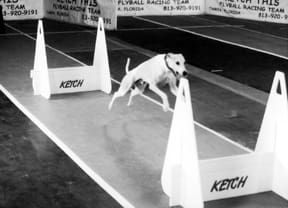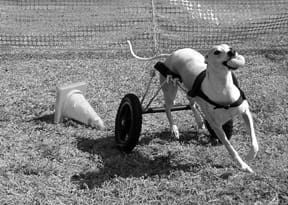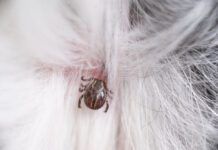Just over a year ago, Cindy Creighton stood in a veterinary neurologist’s office in Fort Lauderdale, gazing at radiographs that showed an incomplete spinal cord injury suffered by her 18-month-old Whippet, Gideon. Two days earlier, the slender young dog had collided with a larger dog while warming up for a flyball competition.
As Creighton listened to the veterinarian, she heard the words downer dog. She saw Gideon himself, a champion flyball dog, immobilized in the animal hospital, though he could squeak the toy she brought him.

Creighton, who for 30 years has worked as an occupational therapist, helping seriously injured human patients find ways to resume their regular lives, made a decision.
“My training is about finding ways for people to do things that matter to them,” says Creighton, 52. “I had a responsibility to Gideon. I took him into my family and I owed him care. There was no question I was going to work with him.”
A canine athlete
The idea of working with her dog predated Creighton’s relationship with Gideon, going back to her decision to get a dog in the first place. First, she first researched breeds. She’d been fascinated by an agility competition she had seen, and thought it would be fun to learn and teach agility to a young dog. After falling in love with Gideon’s mother at a dog show, she decided on a Whippet. She waited a year for the mother to have a litter, and took four-month-old Gideon home in August 2002.
Seeking an outlet for Gideon’s energy, Creighton joined a dog club in February 2003, and took agility and flyball lessons.
He really had potential as an athlete, because he’s fast and he’s bright, says Creighton. It was in flyball the canine relay race where teams of four dogs each dash across a course of low hurdles and retrieve a ball that Gideon literally hit his stride. In just two tournaments he accumulated enough points to earn the title of flyball dog champion, and was running as the lead dog on his team, Raiders of the Lost Bark, based in Miami, Florida.
In a very short time, with him on our team, we were running pretty fast and pretty competitively, says Dana Hanson of Miami, who organized the Raiders. Hanson’s own Whippet, Huey, ran after Gideon. They ran like they’d been running together for 10 years, Hanson says.
The team’s success earned them an invitation to demonstrate flyball at a pet fair in Fort Lauderdale in October 2003. There was even a chance for the legendary 15 minutes of fame for Gideon and the Raiders: Purina pet foods would be there, filming an ad that would run during local broadcast of the Westminster Dog Show.
The pet fair arrived. Purina’s crews filmed and left. It was day two of the pet fair, and the Raiders were warming up, owners calling to dogs, dogs running to owners. Somehow, Gideon and another dog on the team ran into each other.
Gideon at 35 pounds, less than half the size of the other dog took the brunt of the force of the collision. Flyball captains on hand for the fair loaded Gideon into a van and had him at an animal hospital emergency room in 10 minutes. This turned out to be an important factor in his recovery, since he quickly received intravenous steroids, which can mitigate spinal cord swelling.
For the moment, Creighton had to let others do the work for her dog. Some 48 hours later, she got the grim diagnosis from veterinary neurologist Julia Blackmore. Gideon’s hind end was paralyzed due to an incomplete spinal cord injury between his 12th and 13th vertebrae, below his ribcage. Dr. Blackmore warned Creighton that because mobility is so important to them, sighthounds like Whippets don’t usually adapt as well to the loss of function as other breeds. In addition to that mental obstacle, Gideon had physical disadvantages. As a thin dog, his limbs weren’t covered with much padding, making him vulnerable to sores and skin problems from lying down through a long rehabilitation.
But Dr. Blackmore also showed Creighton a section of undamaged nerve fibers, which allowed hope for some return of function how much was impossible to say.
Creighton’s work with Gideon shifted from the fun of training and conditioning for flyball to round-the-clock rituals of nursing care.
Nursing experience helped
At home, the first tasks set the stage for the many to follow that would be resolved through trial and error. Creighton needed a bed with extra padding to counter Gideons susceptibility to sores. She also needed supplies to manage his incontinence. Spinal shock effectively halts bladder function in the first weeks after an accident like Gideon’s, although this function often returns and becomes reflexive. In the meantime, accidents leave the skin wet and prone to breakdown.
To avert sores, Creighton purchased a special bed and changed Gideon’s position in bed every three hours around the clock. By learning to express his bladder and using a combination of a quilted pad in bed and an absorbent wrap while up, plus a daily waterless bath and vigilant monitoring of his skin, she kept Gideon clean and dry.
That regimen, similar to what Creighton had seen prescribed for human patients with spinal cord injuries, lasted about eight weeks. But she shrugs off any suggestion of going above and beyond the call of duty. Almost everyone she knows, she says, has nursed an old pet, or spared no expense for medical care.
I totally understand the importance of that nursing care at the beginning. Investing time and energy early really pays off later, Creighton says.
Keeping movement in mind
Mindful of Blackmore’s warning that Whippets don’t easily adjust to being paralyzed, she was eager to get Gideon moving again, another principle that translated from her professional life.
It’s so important that a person or an animal keeps interest in life, Creighton says. That was one of my motivating forces, especially because he was so young, because he was an athlete. How would I keep him happy?
Creighton used three different techniques in those first few weeks:
A therapy or fitness ball, sized to reach up to his shoulder. Creighton laid the ball against Gideon’s belly, draped his front legs over it, and slowly rolled it back and forth, as a way to teach him to balance and bear his weight on his front legs.
A Walkabout Harness, which fit like a pair of snug shorts, allowing Creighton to lift Gideon’s rear legs, enabling him to walk wheelbarrow-style on his front legs. The Walkabout required another adaptation since Gideon couldn’t feel Creighton steering from the harness, she added a vest that fitted over the shoulders. Equipped with a leash, it allowed her to steer him along with her other hand.

A standing frame similar to a walker a person would use. The Evans Mobility Unit was a lightweight metal frame equipped with wheels and a harness in which Gideon would be suspended, feet touching the floor. In it, Gideon could readjust to being upright and moving.
In addition to the therapy, Creighton simply had to be patient until Gideon confused by his new limitations calmed down long enough for her to be able to get him into her car and take him to more professional help. After equipping the car with a padded cargo liner, Creighton set off for the Animal Recreation and Rehabilitation Center in Davie, Florida, run by Joyce Loeser, a veterinarian specializing in rehabilitation.
Discovering a partner
At ARRC, Creighton found a partner to share her work with Gideon. Besides her DVM training, Loeser’s certified as an acupuncturist, chiropractor, massage therapist, and physical therapist.
“I’m not a strict anything. I’m kind of a fence rider,” says Dr. Loeser. “I kind of believe the black beads and feather theory whatever you need to get the job done.”
In Gideon’s case, that meant acupuncture needles with electrical stimulation to activate his paralyzed leg muscles. Dr. Loeser also tried pool therapy, and sent Creighton home with a catalog of carts canine wheelchairs while Gideon stayed for a few days of intense therapy.
Dr. Loeser considers herself on a mission to change the prevailing veterinary mindset about the quality of life dogs with injuries like Gideon’s can have. The traditional thinking, she says, is he’s down in the rear, you have to express his bladder, (therefore) put him to sleep. Herself a survivor of chronic pain and partial paralysis, a veteran of back surgery, knee surgery, acupuncture, and chiropractic, Dr. Loeser’s practice is dedicated to her belief that a disability does not have to diminish quality of life.
To watch these guys get back on their feet, to get them moving and having a happy, viable life, is the best feeling in the world, she says.
From her first examination of Gideon, Dr. Loeser was optimistic. Tests revealed that Gideon had the ability to feel deep pain in the inner spinal cord. He’d retained the tone he’d acquired in his short canine athletic career, which further indicated something was still stimulating his muscles. And Gideon’s own temperament contributed to his recovery, Loeser says.
Some dogs give up, just like people. They just fold, she says. Gideon never gave up.
Dr. Loeser’s office is a two-story house given over to her practice, surrounded by a three-acre plant nursery that itself is part of the therapy regimen. She and her staff work with the animals outdoors, on grounds that feature tree roots, soft sand, high cut grass all things they would encounter in everyday life.
“These guys don’t recover sitting in stainless steel cages,” Loeser says.
She works to find the right combination of therapy for each animal. Gideon, for instance, hated pool therapy, freezing in the water instead of paddling. With some guys you have to rethink your path and go on to the next one. “Just like anything in medicine, it’s a little bit of an art,” Dr. Loeser says.
Keeping the faith
Creighton worked to weather the ups and downs over the course of Gideon’s rehab. She got a big boost when she picked up Gideon from ARRC the first week of November; with the help of a member of Dr. Loeser’s staff, Gideon actually took steps toward her, with his hind legs following his front legs.
That was followed by a disappointment when Gideon’s custom wheeled cart arrived from Massachusetts-based Eddie’s Wheels for Pets in December. Rather than freeing him to move, Gideon seemed to think the cart restrained him, and wouldn’t budge.
Creighton says her work as an OT helped her deal with disappointments.
This is familiar to rehab professionals. It is a problem-solving process. You expect that some of the equipment isn’t going to work, and there will be a learning curve and resistance sometimes.
She also advises taking the long view.
“The main thing is not to be discouraged in the beginning,” Creighton says. “I had some perspective from working with patients with spinal cord injuries. I know it always looks very discouraging in the beginning, and it gets better. Even if it doesn’t get better physically, they learn how to manage their bodies.”
Creighton’s flexible work schedule also allowed her to engage in hands-on, intensive participation during Gideon’s rehab. She maintained a one-day-a-week clinical practice at a local school. As a faculty member at Barry University in Miami Shores, she taught two weekends a month in a master’s-level program for working adults studying to become occupational therapists. The service-oriented environment at the Catholic university allowed her to bring Gideon to work often. When that wasn’t possible, the supportive staff at Bark Avenue Pet Resort in Hollywood, Florida, filled in, accommodating Gideon and his special needs.
We did that gladly, to get him back on some kind of a track, Bark Avenue owner Paul Funt says. Little by little it was really gradual!Hhe was able to stand, and then take a couple steps. It’s pretty incredible to watch, from a dog that was going to be crippled.
Faith rewarded
After a long month of work in January, Gideon overcame his reluctance to move in the cart. With it, he regained the speed that had made him a leader on the Raiders. (Team leader Hanson says the Raider’s best time, 21.3 seconds, recorded with Gideon running in the lead dog position, still stands.)
To motivate and reward his efforts, Creighton created a modified flyball course, minus the hurdles, in which Gideon would race to retrieve a ball from a traffic cone and bring it back to her. The activity seemed to benefit him more and more. On February 1, they took their first walk without the cart or any special equipment. While slow and a bit awkward, Gideon was moving all four paws on his own! Three weeks later, they rejoined the Raiders (as nonparticipant guests) for the team’s first tournament. While Gideon socialized on the sidelines, Creighton helped with registration. Hanson and his dog, Huey, were thrilled to have them back.
“Huey is just as excited to see Gideon as he ever was,” Hanson says. “We all learned a few things in terms of patience and work paying off.”
Today, Gideon still walks with what Loeser calls a “hypermetric gait,” a somewhat mechanical walk, with wider steps and higher lifts of the legs than he did before his accident. He has to concentrate to walk well, and can fall if distracted, by a squirrel, say. He sleeps on an orthopedic bed and uses raised food and water dishes. Creighton still gets up with him once a night. There’s the occasional potty accident.
But to Gideon, life is as good as it ever was. And Creighton’s starting to think about returning to dog sports. The Raiders have set up a special flyball lane for Gideon when he attends meets, with wooden slats on the ground instead of hurdles, and a ramp up to the flyball box. Creighton is thinking about taking Gideon to lessons for disabled dogs in other sports, like agility and rally. And she and Dr. Loeser have discussed setting up an adapted sports course on the property at Loeser’s Animal Recreation and Rehabilitation Center.
“Why couldn’t there be a special Olympics for dogs?” Creighton asks.
Loeser thinks it’s an idea that has real potential, given the number of disabled dogs and the connection power of the Internet. It could also shatter some beliefs about downer dogs.
“These guys can have an amazing quality of life,” she says. “Gideon is a wonderful example.”
Author Cari Noga is a freelance writer from Traverse City, Michigan.
Thanks to encouragement from Dana Hanson, Cindy Creighton kept an online journal during Gideon’s rehabilitation, both as a way for friends to track his progress and for others to learn from her research. To read the journal, see www.flyballdogs.com/raiders, then click on Gideon’s Rehab.
For more information about the sport of flyball, see www.flyball.org, the Web site for the North American Flyball Association, or write to NAFA at 1400 West Devon Avenue #512, Chicago, IL 60660. Further information and more links are available at www.flyballdogs.com.





